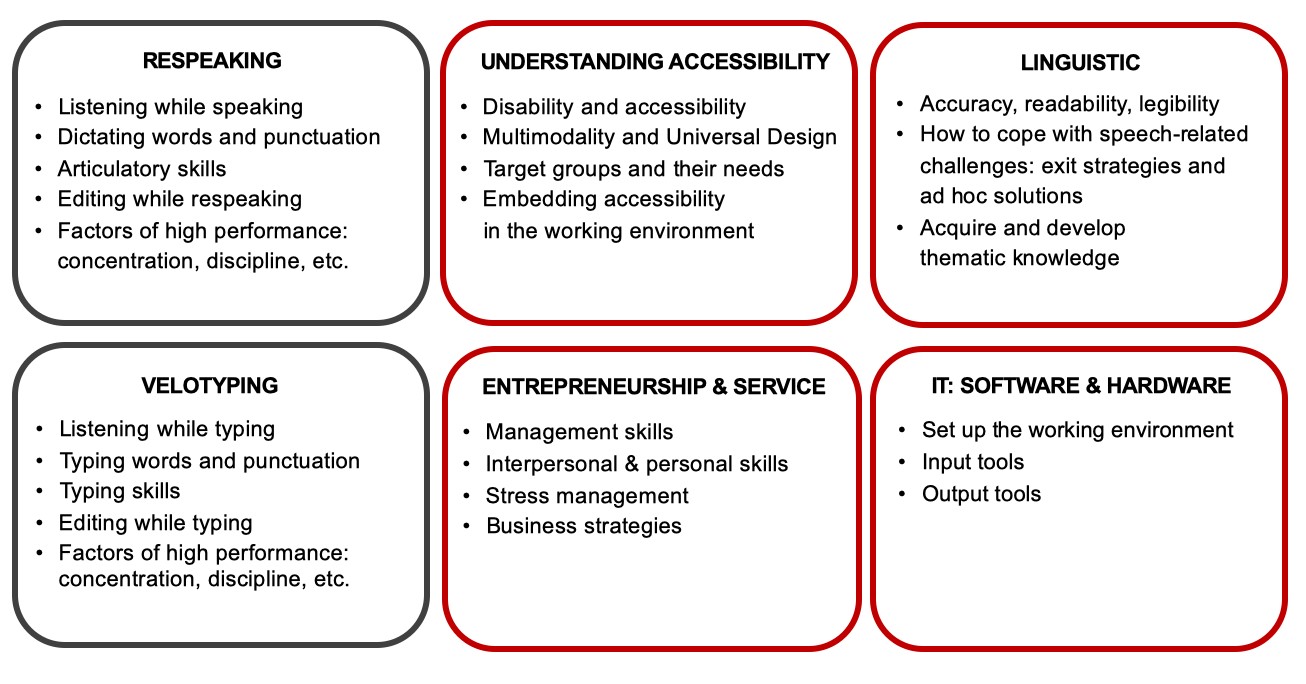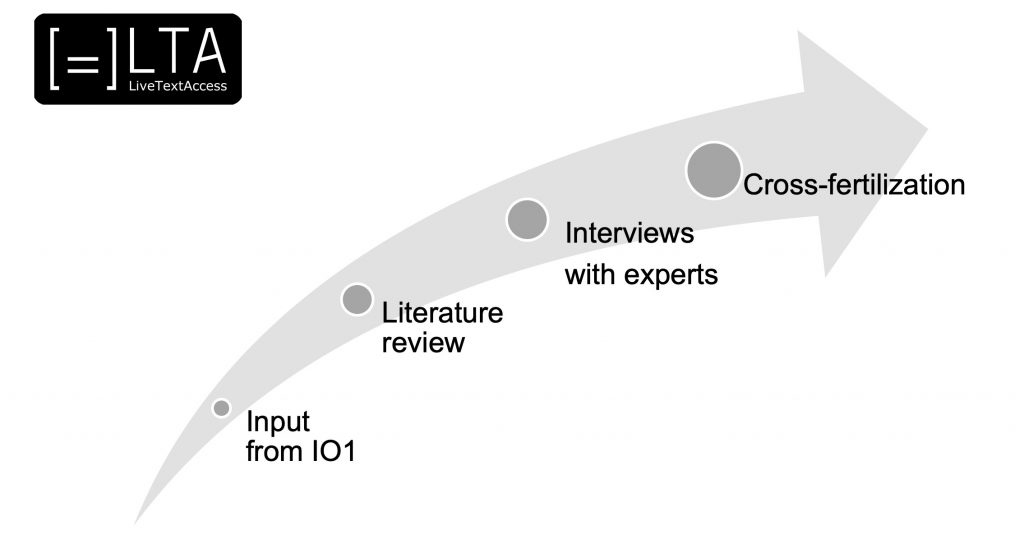Real-time intralingual subtitling has gained momentum as a profession since the adoption of the Convention on the Rights of Persons with Disabilities and as legal frameworks have evolved across Europe and overseas. Training programmes have emerged in higher education and in-house contexts to meet increasing demand for qualified professionals. However, courses often focus on a single technique—either respeaking or keyboard-based production—or work setting, mainly TV broadcasting (Oncins, Eugeni, & Bernabé 2019). As a result, trainees fail to acquire the knowledge and skills necessary to ensure even provision for different work settings, such as broadcasting, parliamentary assemblies, education or the workplace (European Federation of Hard of Hearing People [EFHOH] 2015). This article reports on how the EU co-funded LiveTextAccess project (LTA) aims to approach harmonization in training by providing vocational and higher education institutions with an all-encompassing modular curriculum and open-source training materials, and briefly describes its planned implementation as an online pilot course for beginners.
Project consortium and outputs
LiveTextAccess (www.ltaproject.eu) is a strategic collaboration between educational and non-educational partners that aims to tackle the need for harmonized training in real-time intralingual subtitling. The partnership gathers three universities (SDI München, Universitat Autònoma de Barcelona and the Scuola Superiore per Mediatori Linguistici di Pisa), two accessibility service providers (Sub-Ti Access and Velotype), one broadcasting company (ZDF Digital), one certification association (the European Certification and Qualification Association [ECQA]) and one end-user association (the EFHOH).
The project comprises five working packages called intellectual outputs (IOs) that have two central focuses: competence-based training and certification. On its completion in August 2021, LTA will provide four main outputs: skills cards for respeakers and velotypists, a modular curriculum, open-source learning materials, and a certificate. The first two outputs are discussed briefly in the next sections.
Skills cards for respeakers and velotypists: IO1
Skills cards are descriptions of the knowledge, skills and competences that a professional should possess. As a qualification tool, skills cards map the competence areas related to a professional profile and draw upon the principle of learning outcomes to describe “what a learner knows, understands and is able to do on completion of a learning process”, as defined in the European qualifications framework (Cedefop, 2008: 3) and requested by the ECQA.
In LTA, the skills cards for real-time intralingual subtitlers (RIS) were created with data collected through an online survey during intellectual output 1 (IO1). The full report on the results is available on the LTA’s webpage: Report: skills and competences of RIS. The questionnaire was designed to identify the necessary areas and skills that build the competence profile of an RIS, either through respeaking or the Velotype keyboard. A total of 121 stakeholders provided input from their experiences as professionals, end-users, service providers, trainers or prospective trainees. Answers allowed partners to identify six competence areas for training: understanding accessibility; linguistic competence; IT competence; entrepreneurship and service competence; respeaking competence; and velotyping competence. The results showed that linguistic competence is rated by participants as the most relevant area for the profession, followed by IT, respeaking, velotyping and entrepreneurship and services, and understanding accessibility.
Figure 1 provides a detailed view of the identified competence areas and skills mapped on the LTA skills card.

A curriculum for respeakers and velotypists: IO2
The LTA curriculum draws upon Safar (1992) and Hamaoui’s (2015) Pedagogical and Methodological Curriculum and incorporates input from academics and practitioners. Correspondingly, the teaching, training and evaluation methods are multidisciplinary and build on current practices in the academic fields of simultaneous interpreting and audiovisual translation, and vocational training. The curriculum’s competence-based nature lends versatility in considering the needs of students from diverse educational and professional backgrounds. The curriculum adapts to formal and informal settings and considers three levels of implementation: beginners, intermediate and advanced.
A unique feature of the curriculum is the cross-fertilization of knowledge and expertise between LTA and renowned EU projects such as SCIC (the speech repository project of the European Commission), the EU co-funded projects ILSA (interlingual live subtitling), EASIT (easy-to-understand access services) and ACT (accessible culture and training), and leading associations such as Intersteno. This interconnection has provided additional open-source learning materials and will help to support the sustainability and recognition of LTA training across Europe.
Figure 2 illustrates the curriculum design process for LTA training, beginning with the input of IO1, followed by literature review, expert interviews and cross-fertilization with relevant projects and associations.

The full report describing the rationale of the curriculum and implementation pathways for academic training (BA and MA courses) and 30 ECTS/ECVETS is available on the project webpage: IO2-Report: LTA Curriculum.
LTA course for beginners
During the project, the flexibility of the curriculum’s modular structure will be tested through a pilot course for beginners level. The online platform used will be Moodle. On completion, trainees will possess basic knowledge and skills in respeaking and velotyping, and the general competence areas: accessibility, linguistics, entrepreneurship and service, and IT. During the course, trainees will have access to beginner-level exercises to practise subtitling techniques, as well as to videos and readings on conceptual and practical aspects of real-time subtitling in different working contexts.
Conclusions
Since the adoption of the Convention on the Rights of Persons with Disabilities, the European Union has set a legal framework that obliges member states to grant access to content to end-users. To satisfy demand for qualified RIS, LTA will provide modular, open-source and competence-based training for academic and vocational institutions. The planned certificate in English aims to support recognition of the profession and set quality standards in training.
Rocío Bernabé is the deputy Head of the Professional College of Translation and Interpreting of the Internationale Hochschule SDI in Munich, Germany. Estella Oncins has a PhD in Accessibility and Ambient Intelligence and works as post-doctoral research fellow at the research group TransMedia Catalonia in Universitat Autònoma de Barcelona.
Acknowledgements
This work has been partially funded by the ERASMUS+ LTA2018-1-DE01-KA203-004218 and 2019SGR113.
References
CEDEFOP. (2008). The European qualifications framework for lifelong learning (EQF). Retrieved from: http://relaunch.ecompetences.eu/wp-content/uploads/2013/11/EQF_broch_2008_en.pdf
EFHOH. (2015). State of Subtitling Access in EU – 2015 Report. Retrieved from: http://www.efhoh.org
Hamaoui, N. (2015). Pedagogical and Methodological Curriculum (PMC) in Training Audiovisual Translation. Retrieved from: https://umons.academia.edu/NajwaHamaoui
Oncins, E., Eugeni, C., & Bernabé, R. (2019). The Future of Mediators for Live Events: LTA Project – Academic and Vocational Training. Cultus: the Journal of Intercultural Mediation and Communication 12.
Safar, H. (1992). Curriculum d’Éducation et Projet Pédagogique. Parigi: Éditions du Cercle.




